Sewage flushing: pipe cleaning methods + main causes of blockages
Effective operation of the wastewater disposal system in an apartment or home requires timely preventive measures. But if a blockage does occur, then properly flushing the sewer will eliminate the everyday inconvenience that this problem entails.
It is necessary to understand that in addition to minor troubles, a non-functioning or inefficient sewer system can also lead to larger consequences associated with damage due to flooding.
Let's look together at the causes of clogged sewer pipes and how to eliminate them.
The content of the article:
Options for flushing sewer pipes
There are many methods for clearing blockages in the sewer system.
In order to correctly determine the most optimal one in a specific situation, you must first find out:
- the degree of blockage and, accordingly, the complexity of work to remove it;
- design features of the sewerage system and its length.
Each of the ways to solve a problem associated with a violation of drainage from an apartment or home requires the availability of appropriate tools, equipment or special means.
Let us consider in detail the basic techniques used to flush the pipes of the sewerage system in an apartment or home.
Option number 1 - spilling with water
Minor disturbances in the capacity of sewer pipes, as a rule, occur due to fat deposits in them. Added to these accumulations are small fractions of household waste that fall into the sink drain, for example, from the kitchen when washing dishes. Therefore, a blockage situation often occurs in a section of the pipeline that is slightly removed from the kitchen sink.
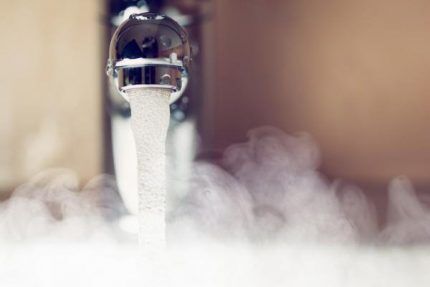
To begin with, plugs are installed (can be made from a wet rag, if there is no standard one) on the holes for water overflow, after which hot water, approximately 60 °C, is supplied to the sewerage system under the maximum possible pressure from all water points.
Under the influence of excess pressure and water temperature, small plugs or fatty deposits will be washed away.
It must be remembered that this procedure is carried out under constant supervision to avoid water overflowing through the sink.
Cool boiling water will work well when flushing pipes. A volume of 1-2 liters is often enough to wash away fatty deposits.
But some peculiarities of using boiling water should be taken into account. It will not harm good modern plastic pipes, especially cast iron pipes. However, the main thermal shock will occur on siphon, the material of which, like the rubber seals used for sealing, is much less resistant to the effects of hot water than pipes.
Option No. 2 - using a plunger
Additional assistance when flushing the sewer system can be provided by a plunger, which is advisable to have in your arsenal to combat clogged pipes in every home.
Depending on the intended use (sink, bath or toilet), plungers may differ in the volume of the bowl and the angle of its attachment to the handle.
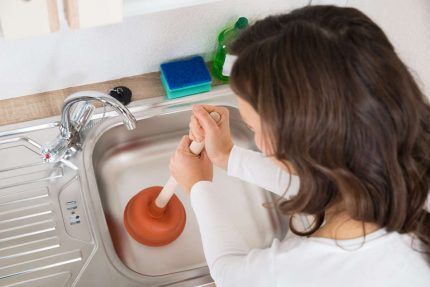
The method of using a plunger is quite simple. The step-by-step instructions are as follows:
- The sink or bathtub is filled with a small amount of hot water, with a level of a few centimeters at the drain hole, but not exceeding the height of the valve.
- Plug the overflow hole.
- The bowl of the plunger, like a suction cup, closes the drain hole.
- Several intense pumping motions are performed, after which the device is abruptly removed.
When the plunger works effectively, elements of contaminants come out of the hole along with wastewater, some of which can be removed before they return to the system. The drain is filled with water again, and the pumping procedure is repeated several times until the cause of the blockage is completely eliminated.
In addition to conventional plungers, the modern sanitary equipment market offers a large assortment of their pneumatic counterparts, which successfully cope with clogs in apartment sewers.
Some products can be classified as professional equipment, with an appropriate price.But there are also quite decent quality and affordable devices - from 500 to 1000 rubles.
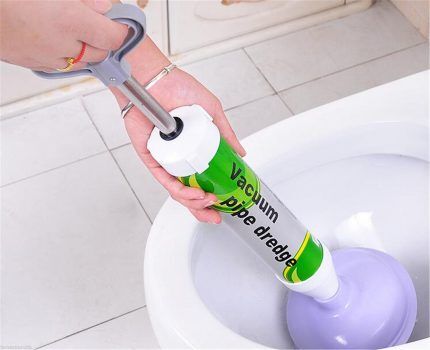
The undoubted advantage of these devices over a traditional plunger is the greater power of the hydraulic shock. The cylinder volume, depending on the model, is usually from one to two liters. The device is usually equipped with two adapters: one for sinks, bathtubs and the second for the toilet.
The work of cleaning the sewer is completed using plungers of any type by flushing the pipes with hot water.
Option No. 3 - use of special means
The use of household chemicals is another method of flushing drains and sewage systems from blockages that allows you to get the desired result.
The following types of means used are distinguished:
- liquid;
- gels;
- granules (powders).
We will tell you how to flush drains, siphons and sewer pipes using preparations of each specified type using the example of the most popular modern means.
Synergetic to remove blockages. This is a concentrated liquid. Contains A-tensides of plant origin, soda and water. According to the manufacturer, it is completely natural.
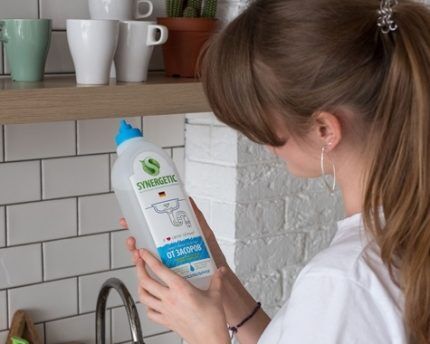
Advantages of Synergetic:
- does not cause allergies;
- contains substances capable of complete biodegradation in water into harmless components - water and carbon dioxide;
- fights bacteria;
- harmless to the microflora of septic tanks.
The liquid works effectively in drains of plumbing fixtures, eliminates fatty deposits and unpleasant odors, but it will not cope with severe blockages and plugs with hair inclusions.
Sanfor - thick gel. 250 ml of product is poured into the drain hole. For small blockages, it is enough to wait from 5 to 15 minutes, for severe ones - a little more, and after that, flush the system for a minute under strong water pressure.
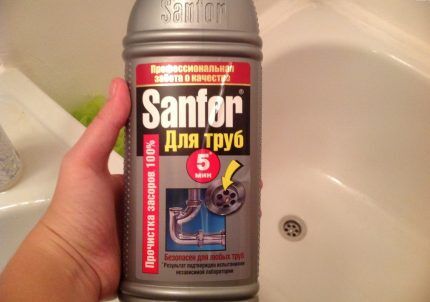
Based on the majority of real user reviews, we can conclude that the gel, for its price of 110 rubles, is really effective and better than many expensive chemicals in combating blockages and sewer odors.
A 750-gram bottle is just enough for a one-time cleaning procedure for three drains (kitchen, bath and toilet).
The only advice from housewives is, if possible, leave the gel poured into the pipes, without spilling, for a longer period than indicated in the instructions. Moreover, the product is safe for all types of communications.
Bagi granules for blockages Pothan. The product is supplied in a 250 gram container.
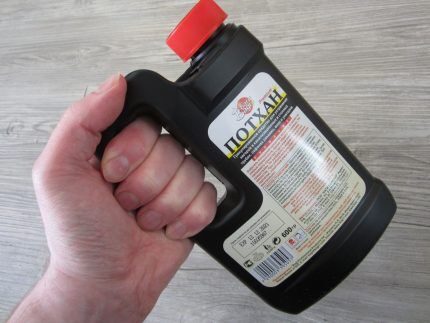
After 3 minutes, thoroughly rinse the pipe under the maximum possible water pressure.
During the reaction, an unpleasant odor and foam may be released.Therefore, it is necessary to work with the drug very carefully and wear skin and respiratory protection.
Despite the apparent aggressiveness of the product, users confirm that it does not cause any harm to the coating of plumbing fixtures. The powder has a good rating and a large number of offers on online resources.
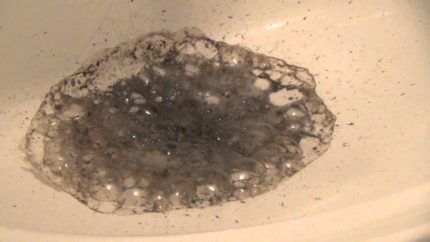
Option number 4 - traditional methods
There are methods that allow you to flush pipes without using specially purchased ready-made products. Knowledge of the main components that make up the drugs and the chemical processes that occur when they interact with other substances helps in this.
Caustic soda - caustic soda. This is an alkali with a fairly wide range of applications - from cooking and cosmetics, to industrial washing and fuel production on a large scale.
Caustic, which has the property of decomposing organic substances, is part of many household products, including those intended to clear sewer blockages.
In a dry substance, caustic soda can be granular and flake.

Spilling the sewer with running water after the procedure using caustic soda should be done no earlier than 2 hours later.
Baking Soda and Vinegar. For one drain you need to prepare up to 250 g (half a pack) of soda and 100-150 g of vinegar. Soda is poured into the drain in dry form; it cannot be mixed with water.Before pouring the prepared vinegar into the drain hole, it is advisable to warm it up a little in the microwave or a container of hot water.
Immediately after pouring vinegar, the hole should be plugged as tightly as possible with a rag so that the action of the chemical reaction is directed inside the pipe. After half an hour, boiling water is poured into the drain (you can use a whole kettle), and the system is drained from the water supply.
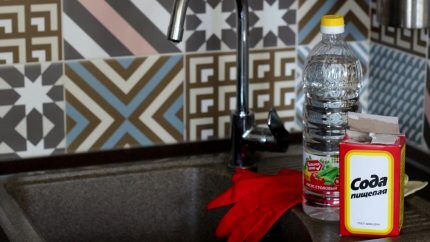
But this method can be effective if it is possible to properly seal the entire waste system, including drains and overflow holes.
The argument is that the reaction is accompanied by the release of a large amount of carbon dioxide, the force of which, in the absence of leaks, may be sufficient to simply push the resulting plug further into the sewer and get rid of it by subsequent drainage of the system.
Option No. 5 - hydrodynamic flushing
The use of chemicals and other special means can bring the expected effect if the blockage is organic. But even organic matter, in large quantities or pressed, can resist these methods of cleaning pipes. And there is no talk at all about dissolving plugs formed from construction waste or other large inorganic waste that has entered the sewer system.
Therefore, to flush pipes with large blockages, you should resort to the modern hydrodynamic method. To implement this method, you need special equipment that can be used both in everyday life and in production.
The permissible diameter of pipelines served by the hydrodynamic method is from 50 to 300 mm.
The hydrodynamic kit consists of a hose that can withstand high water pressure and a nozzle with nozzles. For residential sewage systems, as a rule, triangular (punching) nozzles are used. A good turner is quite capable of making a punch attachment on his own.
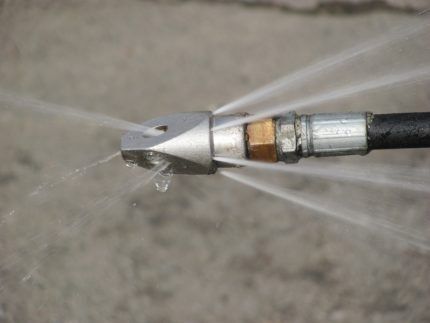
Step-by-step sewer flushing using hydrodynamics is as follows:
- determining the nature and degree of complexity of the blockage and, based on this, selecting a nozzle;
- immersing a hose with a nozzle into the sewerage system and connecting a pump;
- using reciprocating movements, moving the hose with the tip towards the blockage;
- increasing, if necessary, the power of water pressure until the result is achieved.
This method effectively destroys and flushes even the most stubborn, hard-to-reach clogs. Most often it is used to eliminate blockages in the sewer system of a private home and in industrial networks.
If it is not possible to resort to hydrodynamic flushing, you should use plumbing cable. It also copes quite effectively with blockages in sewer pipes.
The main causes of clogged pipes
There may be several reasons why problems with the normal functioning of the sewage system periodically arise. However, in any case, the main condition for its normal operation is the timely and correct implementation of preventive measures.
Reason #1 - fat deposits
The first reason is those fatty deposits or organic plugs, which were discussed above and which inevitably arise during the operation of the sewage system, mainly when washing dishes.
An effective way to combat fat deposits can be grease trap, mounted under the kitchen sink. The main function of this device is to separate grease from wastewater.
The design of such a device is quite simple, and if desired and with the right approach, it can be made independently from available materials.
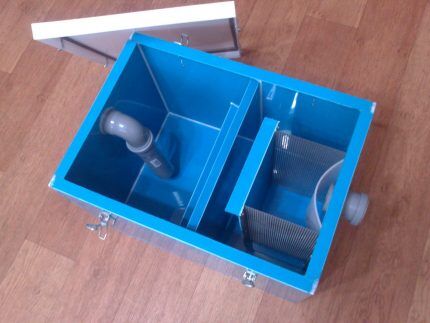
Fatty formations, lighter than water, remain on the surface of the first compartment, and fat-free wastewater, passing through the upper gap of the second partition, enters the sewer.
A general preventative measure to prevent the accumulation of grease and small pieces of food waste in pipes is to periodically, preferably at least once or twice a week, flush the sewer system with hot water at the maximum possible pressure. This procedure must be carried out from 5 to 15 minutes.
Reason #2 - hair plugs
Hair causes a lot of trouble, especially in drains from showers and bathrooms. To prevent the formation of hair plugs, it is necessary to create a barrier for hair to enter the sewer.
In large quantities and in various variations, you can find protective grilles on sale that cover the drain hole or are attached to the bottom of the sanitary appliance using suction cups.
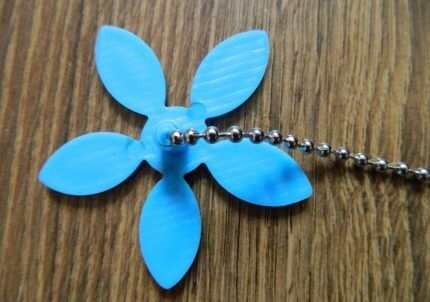
The chain is lowered into the drain and hair, as well as other debris, is retained on the restrictors and does not fall further into the sewer system. All that is necessary is to periodically remove the chain and clean it.
This item, in addition to being useful, also performs a decorative function.
Reason No. 3 - deposits in siphons
A common cause of blockage is deposits that have accumulated in the bends of the exhaust siphon. These devices have a useful purpose - they provide water seal.
Due to the design features, there is always waste water at the bottom of the siphon, which, by creating pressure in the system, prevents sewer odors from penetrating into the room.
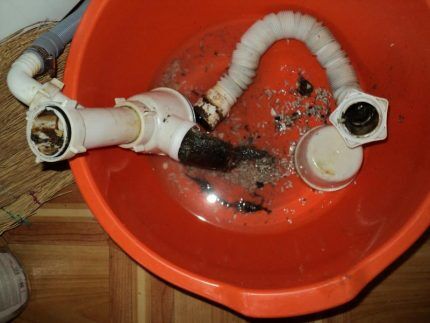
Disassembling and cleaning the siphon will not be difficult, but the benefits of this work are undoubted. Removal of not only large debris, but also high-quality flushing of all parts of the siphon from grease and small waste is a guarantee of stable operation of the sewage system.
Reason #4 - installation errors
Structural or technical blockage is the result of violations committed during the construction of the sewer system or complications that arose during its operation.
The main reasons for this may be:
- insufficient diameter of sewer pipes;
- improperly installed drainage system;
- subsidence or break of a sewer pipe;
- failure to comply with the minimum pipe slope.
In case of such malfunctions, any preventive measures and work to flush the system will only give temporary results.
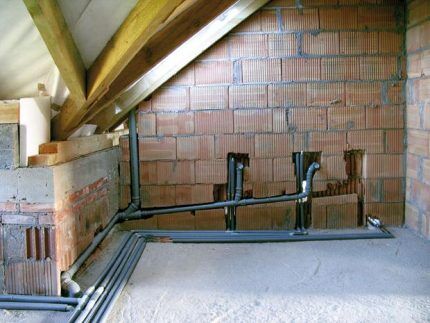
Therefore, in order to save yourself from constant problems with the sewerage system, it may be better to immediately resort to “surgical measures” - to repair or replace the sewerage system or its faulty part.
Reason #5 - overgrowing sewer drains
Cast iron and steel pipes that have been in use for a long time are often susceptible to this problem. The roughness formed on their inner surface causes snags of hair, threads and other small debris, which over time become overgrown and become the center of the plug. And grease from kitchen sinks and dishwashers makes the situation worse.
For preventive cleaning of a sewer system made of cast iron and steel, the flushing methods described above are quite acceptable. But an effective solution, albeit somewhat drastic, would be to replace such pipes with metal-plastic.
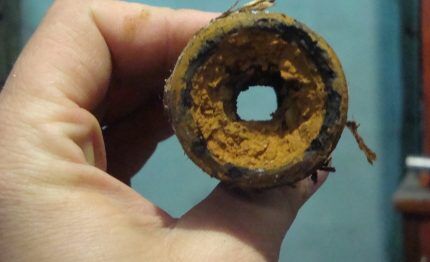
Reminder on the correct use of sewerage
Despite the fact that every adult knows the purpose of the sewer system, often the result of its malfunction is the human factor. The confidence that everything will “slip” into the sewer gives the short-sighted resident a reason to dump anything into the system.
The main prevention against blockages for this reason is a reminder that under no circumstances should you throw into the sewer:
- large food debris and fats;
- construction garbage;
- paper, if it is not dissolvable toilet paper;
- thick paper towels;
- diapers, wet wipes and cotton swabs;
- pads and condoms;
- pet litter;
- adhesive plasters and dental floss.
It is necessary to firmly understand that a sewer is not a garbage chute.
Therefore, the temptation to quickly throw something that is no longer needed into the toilet, rather than into the trash can, and forget about it, must be countered by an understanding of the consequences that such actions will lead to, and which will soon remind of themselves.

Conclusions and useful video on the topic
A video showing in detail the procedure for cleaning and rinsing with your own hands the elements of drain siphons under the bathtub, sink and kitchen sink:
The video talks about how to clean a sewer system using caustic soda:
A short video about the procedure for hydrodynamic flushing of a sewer system in an apartment:
The considered options for eliminating the causes of blockages in the sewage drainage system by flushing are the most effective. Their effectiveness and the ability to perform at home have been confirmed in practice.
Knowledge of the given instructions and tips for sewerage maintenance and prevention, as well as their observance, will help avoid undesirable consequences and provide the opportunity to use plumbing equipment comfortably.
If you know other effective ways to clear drains from blockages and use them effectively, please share your experience with other visitors to our site. Leave your comments in the communication block located under the article.




Informative. However, if blockages are frequent, then an error in the design of communications is inevitable. I have the same problem with hydrobox. The drain is located almost at the level with the outlet pipe, so gravity flow is difficult. Well, the second reason is long hair. Here, as it is written, a catcher and a plunger come in handy, which very effectively helps to push through or remove an obstacle that seems to have already been washed away and is preventing the effective drainage of water. Fats and deposits develop over the years.
Most blockages occur over the years when the diameter of the pipe decreases due to build-up.
The description of folk methods makes my hair stand out. In modern bathrooms and kitchens, at least 90% of cases have plastic siphons installed. I don’t know about caustic soda, but baking soda with vinegar, subsequently supplemented with boiling water, is, if not a death sentence, then a very high risk of getting, as a bonus to the blockage, deformation and even leakage of the siphon or corrugated tube (which is even more likely). Pouring boiling water into a plastic drainage system is cool)))
What you write is nonsense, these folk remedies do not consist of aggressive chemicals and the siphon will not be harmed by them. There's a joke about boiling water. No pipe is deformed by boiling water; they hold up to 140 degrees according to the standard.
Polyvinyl chloride - 110-120 - loss of shape, deformation, polypropylene - 85-95 degrees, polyethylene - 60-65 degrees holds, but not higher, cross-linked polyethylene - 90-100 degrees (holds higher, but for a short time). These are GOST values. And this despite the fact that the material will not be recycled and will be 100% high quality, which is rare.